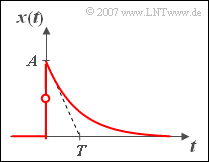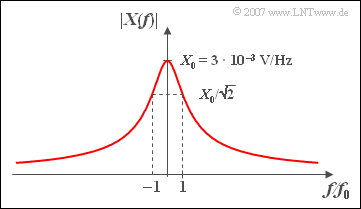Difference between revisions of "Aufgaben:Exercise 3.1: Spectrum of the Exponential Pulse"
| Line 105: | Line 105: | ||
:$$\Rightarrow \hspace{0.5 cm} \left| {X( {f = f_0} )} \right| = { {X_0 }}/{ {\sqrt 2 }}\hspace{0.15 cm}\underline{ = 2.12 \;{\rm mV/Hz}}.$$ | :$$\Rightarrow \hspace{0.5 cm} \left| {X( {f = f_0} )} \right| = { {X_0 }}/{ {\sqrt 2 }}\hspace{0.15 cm}\underline{ = 2.12 \;{\rm mV/Hz}}.$$ | ||
| − | *At very high frequencies $(f \rightarrow \infty)$ the magnitude is<u>almost zero</u> (see sketch). | + | *At very high frequencies $(f \rightarrow \infty)$ the magnitude is <u>almost zero</u> (see sketch). |
Revision as of 21:55, 16 January 2021
In this task, a causal signal $x(t)$ is considered
- which rises abruptly from zero to $A$ at time $t = 0$ , and
- decreases exponentially with the time constant $T$ for $t > 0$ :
- $$x(t) = A \cdot {\rm e}^{ - t/T} .$$
At the saltus at time $t = 0$ , $x(t = 0) = A/2$.
Use the following parameters for the numerical calculations:
- $$A = 3 \hspace{0.1cm} {\rm V}, \hspace{0.4cm} T = 1 \hspace{0.1cm} {\rm ms} .$$
The spectral function $X(f)$ to be calculated will be complex and therefore can be
- by real and imaginary part, but also
- by magnitude and phase
can be represented. Use the notation
- $$X( f ) = \left| {X( f )} \right| \cdot {\rm e}^{ - {\rm j} \hspace{0.05cm}\cdot \hspace{0.05cm} \varphi( f )} .$$
Hints:
- This exercise belongs to the chapter Fourier Transform and Its Inverse.
Questions
Solution
- $$X( f ) = \int_0^\infty {A \cdot {\rm e}^{ - t\left( {1/T + {\rm j \hspace{0.05cm} \cdot \hspace{0.05cm}}2\pi f} \right)} } {\rm d}t = \left. {\frac{ { - A}}{ {1/T + {\rm j}2\pi f}} \cdot {\rm e}^{ - t\left( {1/T + {\rm j}2\pi f} \right)} } \right|_0^\infty .$$
- The upper integral limit $(t \rightarrow \infty)$ gives zero, the lower limit $(t = 0)$ gives the value $1$. Thus:
- $$X(f) = \frac{ {A \cdot T}}{ {1 + {\rm j}2\pi fT}}\hspace{0.3 cm}\Rightarrow\hspace{0.3 cm} X( {f = 0}) = A \cdot T{ = 3 \cdot 10^{ - 3}\; {\rm V/Hz}} \hspace{0.15 cm}\underline{ = 3 \; {\rm mV/Hz}}.$$
- At the frequency $f = 0$ , the spectrum is therefore purely real:
- $$\text{Re}[X(f=0)] \hspace{0.15 cm}\underline{ = 3 \; {\rm mV/Hz}} \hspace{1.15 cm}\text{Im}[X(f=0)] \hspace{0.15 cm}\underline{ =0}.$$
(2) With the abbreviations $X_0 = A \cdot T$ and $f_0 = 1/(2\pi T)$ the spectral function is:
- $$X( f) = \frac{ {X_0 }}{ {1 +{\rm j} \cdot f/f_0 }} = \frac{ {X_0 }}{ {1 + \left( {f/f_0 } \right)^2 }} \cdot \left( {1 - {\rm j} \cdot f/f_0 } \right).$$
Divided into real and imaginary parts, this gives:
$${\mathop{\rm Re}\nolimits} [ {X(f)}] = \frac{ {X_0 }}{{1 + \left( {f/f_0 } \right)^2 }}, \hspace{0.5 cm}{\mathop{\rm Im}\nolimits} [ {X(f)}] = - \frac{ {X_0 \cdot f/f_0 }}{ {1 + \left( {f/f_0 } \right)^2 }}.$$
At the frequency $f_0$
- the real part is equal to $X_0/2 \hspace{0.15 cm}\underline{ = 1.5 \; {\rm mV/Hz}},$
- the imaginary part is equal to $–X_0/2 \hspace{0.15 cm}\underline{ = \hspace{0.1 cm}-1.5 \; {\rm mV/Hz}}.$
(3) The magnitude of a complex-valued function, which is a quotient, is equal to the quotient of the magnitudes of the numerator and denominator.
- Thus one obtains:
- $$ \left| {X( f)} \right| =\frac{ {X_0 }}{ {\left| 1 +{\rm j} \cdot f/ {f_0 } \right|}} = \frac{ {X_0 }}{{\sqrt {1 + \left( {f/f_0 } \right)^2 } }},$$
- $$\Rightarrow \hspace{0.5 cm} \left| {X( {f = f_0} )} \right| = { {X_0 }}/{ {\sqrt 2 }}\hspace{0.15 cm}\underline{ = 2.12 \;{\rm mV/Hz}}.$$
- At very high frequencies $(f \rightarrow \infty)$ the magnitude is almost zero (see sketch).
(4) The general rule for the phase function is:
$$\varphi ( f ) = \arctan \left( {\frac{ { - {\mathop{\rm Im}\nolimits}[{X(f)} ]}}{{ {\mathop{\rm Re}\nolimits} [ {X(f)} ]}}} \right) = \arctan \left( {f/f_0 } \right).$$
- For $f = f_0$ this gives $\arctan(1)= \pi /4 \hspace{0.15 cm}\underline{\approx 0.785}$.
- For very large values of $f$ the phase function approaches $\arctan(\infty) = \pi /2 \hspace{0.15 cm}\underline{ \approx 1.571}$ an.
- Both specifications are to be understood in radians.

